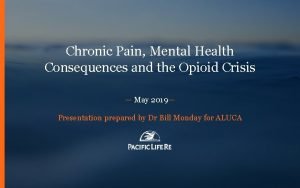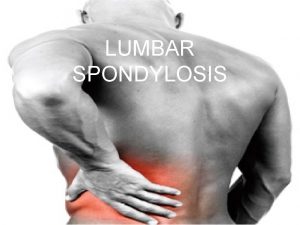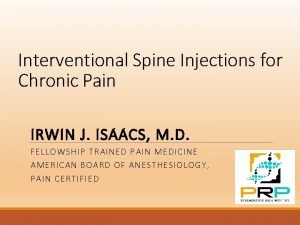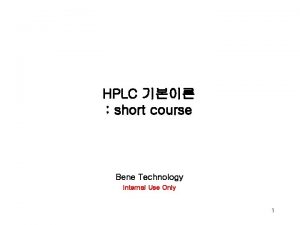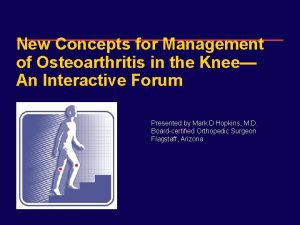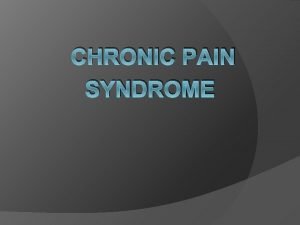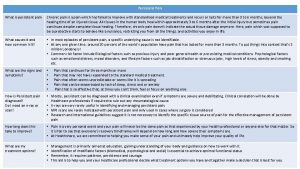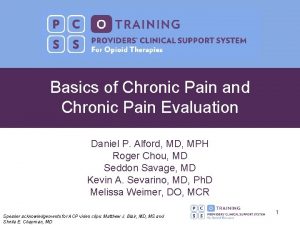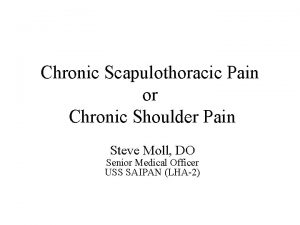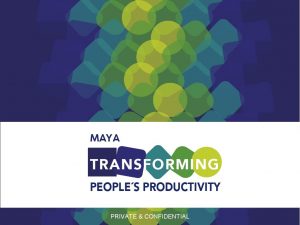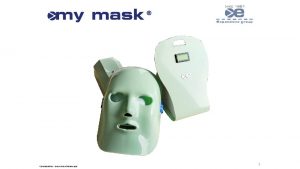FOR INTERNAL USE ONLY PRIVATE CONFIDENTIAL Chronic Pain































- Slides: 31

FOR INTERNAL USE ONLY | PRIVATE & CONFIDENTIAL Chronic Pain, Mental Health Consequences and the Opioid Crisis — May 2019— Presentation prepared by Dr Bill Monday for ALUCA Pacific Life Re

FOR INTERNAL USE ONLY | PRIVATE & CONFIDENTIAL Pain- Acute and chronic (Darwin award contender) Shutterstock 121018252 Pacific Life Re 2

FOR INTERNAL USE ONLY | PRIVATE & CONFIDENTIAL Agenda: • • • Overview of pain in Australia Types of pain Pain assessment and measurement Treatment options for pain Side effects of treatment and worrying combination of drugs and substance abuse Multi-disciplined approach to pain management Psychological aspects of pain Opioids Conclusion Pacific Life Re

FOR INTERNAL USE ONLY | PRIVATE & CONFIDENTIAL Aim of talk: • • • Provide a reference for the assessment and management for chronic pain Areas to consider when assessing chronic pain Information that would be valuable in assessing pain Discuss comorbidity including biopsychosocial aspects of chronic pain Checklist when assessing pain from either an underwriting or claims perspective Pacific Life Re

FOR INTERNAL USE ONLY / PRIVATE & CONFIDENTIAL Chronic Pain- Also known as persisting pain • Definition- Pain that continues for more tan 3 months after surgery, an injury, as a result of disease, or from another cause 1 • Chronic pain affects 3. 2 million Australians 1, 2 • Chronic pain is debilitating and can have an adverse effect on work, sleep and relationships. 1 • People with chronic pain often experience comorbidities such as depression, sleep disturbance and fatigue 1 • Out of pocket Healthcare costs paid by Australians is $2. 7 Billion 3 Shutterstock 732789853 1. Karapetyan, A. A. , & Manvelyan, H. M. (2017). Chronic Pain and Depression. In. Tech. 2. Australian Health Survey 2011 -2012 3. Painaustralia Pacific Life Re

FOR INTERNAL USE ONLY / PRIVATE & CONFIDENTIAL Chronic Pain Use of non opioids and opioids by age The prevalence of pain and analgesia use in the Australian population. Findings from the 2011 -2012 Australian National Health Survey. April Miller et al. August 2017. Pharmacoepidemiol Saf ; 201726, 1403 -1410 Pacific Life Re

FOR INTERNAL USE ONLY | PRIVATE & CONFIDENTIAL Types of Pain Nociceptive Pain – This is caused by damage to body tissue and is usually described as sharp, aching or throbbing. Caused by injury, surgery, arthritis, osteoporosis or musculoskeletal conditions 1 Neuropathic Pain- This occurs following damage to the nervous system itself and associated sensations are often described as burning or shooting pains. 2, 3 1. Willis, J. W. (1985). The pain system. The neural basis of nociceptive transmission in the mammalian nervoussystem. Pain and Headache, 8, 1 -346. 2. Treede, R. D. , Rief, W. , Barke, A. , Aziz, Q. , Bennett, M. I. , Benoliel, R. , . . . & Giamberardino, M. A. (2015). Aclassification of chronic pain for ICD-11. Pain, 156(6), 1003 Shutterstock 229165600 3. Painaustralia Pacific Life Re 7

FOR INTERNAL USE ONLY / PRIVATE & CONFIDENTIAL Neuropathic Pain Lyrica (Pregabalin) Used for Neuropathic pain is caused by damage, injury Should use other medication first such as or dysfunction of nerves due to trauma, anti-depressants. surgery, disease or chemotherapy. Is prescribed for severe refractory pain. Prevalent forms of neuropathic pain Diabetic Peripheral Neuropathy Common side effects include dizziness and drowsiness An example for its use is Diabetic neuropathy Post herpetc neuralgia Cancer related pain Spinal cord injury Reflex sympathetic dystrophy Multiple sclerosis Phantom limb pain Post stroke pain HIV associated pain Trigeminal neuralgia Pacific Life Re 8

FOR INTERNAL USE ONLY / PRIVATE & CONFIDENTIAL Complex regional Pain Syndrome -CRPS, (Causalgia, Reflex Sympathetic Dystrophy) • • • Is a chronic regional pain syndrome Mostly affects one limb usually after injury Caused by damage to, or malfunction of the peripheral and central nervous system Those without confirmed nerve injury are classified as CRPS – I ( Reflex Sympathetic Dystrophy) and CRPS –II (Causalgia) have known nerve injury In severe cases patients may not recover and may become disabled Symptoms include: • Changes in skin colour, temperature • Swelling of affected limb • Stiffness of affected joints • Problems with coordination of limb Picture taken by Timsong 311 Pacific Life Re 9

FOR INTERNAL USE ONLY / PRIVATE & CONFIDENTIAL Pain Assessment 1. 2. 3. 4. 5. 6. 7. 8. 9. Site of Pain Circumstances associated with pain on set Characteristics of pain Intensity of pain Associated symptoms Effect of pain on activities of sleep Treatment to date Relevant medical history Factors influencing the patient’s symptomatic treatment Shutterstock 372012958 Pacific Life Re

FOR INTERNAL USE ONLY | PRIVATE & CONFIDENTIAL Measuring Pain Assessment Tools • Verbal Numerical Rating Score ( VNRS) and faces pain scale • DN 4 for Neuropathic pain • Brief Pain inventory form • Worst pain in last 24 hours • Least pain in last 24 hours • Average pain in last 24 hours • Relief from treatment • How has pain interfered with: • General activity • Mood • Walking ability • Normal work • Relation with other people • Sleep • Enjoyment with life Chronic Pain grade (CPG)- duration, intensity and disability Grades I-IV (23. 6% I, 37. 8% II, 29. 6% III, 9% IV – AIHW 2010) Shutterstock 693213469 Pacific Life Re

FOR INTERNAL USE ONLY / PRIVATE & CONFIDENTIAL Treatment options* • Pharmacological • Surgery • Paracetamol • Nerve blocks • Anti-inflammatories • Intrathecal drug delivery systems • Antidepressants, • • Anticonvulsants Transcutaneous Electrical Nerve Stimulations (TENS) • Opioids • Spinal cord and peripheral nerve stimulators – (Treatment for depression) – (Treatment for anxiety) • Non Pharmacological • Physiotherapy, ( range of motion therapy, muscle strengthening, postural training) • Psychological Treatment • CBT ( Understanding pain, pain and tension, thoughts, emotions and behaviour. Lifestyle changes, better sleep patterns, better coping skills for pain and other stressors). Paced activities and relaxation * Chronic Pain Management Strategies. www. aci. health. nsw. gov. au/chronic-pain Pacific Life Re 12

FOR INTERNAL USE ONLY / PRIVATE & CONFIDENTIAL Treatment of Neuropathic Pain Class of Drug Examples Topical patches Lidocaine patches Antidepressants ( Tricyclic antidepressants and SNRI’s) Amitriptyline (Endep) , Nortriptyline, Imipramine (Tofranil) Duloxetine (Cymbalta), Venlafaxine (Effexor) Anticonvulsants Carbamazepine (Tegretol), Sodium Valproate (Epilim), Lamotrigine (Lamictal), Pregabalin (Lyrica), Gabapentin ( Neurontin) Opioids See later slide Pacific Life Re 13

FOR INTERNAL USE ONLY | PRIVATE & CONFIDENTIAL Transcutaneous Electrical Nerve Stimulations (TENS) Shutterstock 115129090940 Pacific Life Re 14

FOR INTERNAL USE ONLY | PRIVATE & CONFIDENTIAL Spinal Cord Stimulator Image sources ADTRR 78 and Wikipedia Pacific Life Re 15

FOR INTERNAL USE ONLY / PRIVATE & CONFIDENTIAL Complex regional Pain Syndrome treatment 1 • • • Picture taken by Timsong 311 Prolonged severe pain that may be constant. Pain may spread to whole limb even though injury may be to a small part of the limb Treatment: • Rehab (early intervention) • Psychotherapy ( prone to anxiety, depression, PTSD) • Medication • Biphosphonates, NSAIDS, Steroids, antiepileptics, antidepressants, botulinum toxin injections, opioids, NMDA receptor antagonist (Ketamine), topical local anaesthetic creams and patches, IVG • Nerve blocks, sympathectomy, spinal cord stimulation, intrathecal drug pumps 1. Complex regional Pain Fact Sheet- National Institute of Neurological disorders and stroke Pacific Life Re 16

FOR INTERNAL USE ONLY / PRIVATE & CONFIDENTIAL Multidisciplinary approach to pain 1 • • Unimodal treatment- A single therapeutic intervention Multimodal treatment- Concurrent use of separate therapeutic interventions with different mechanisms of action Multidisciplinary treatment- multimodal treatment provided by different practitioners Interdisciplinary treatment- multimodal treatment provided by a multidisciplinary team collaborating in assessment and treatment using shared biopsychosocial model and goals 1. Painaustralia 2018 b 2. Blanchard M. , Tardif H. , Fenwick N. , Blissett C. & Eagar K. (2017). Electronic Persistent Pain Outcomes. Collaboration Annual Data Report 2016. Australian Health Services Research Institute, University of. Wollongong. 3. Gatchel, R. J. , & Okifuji, A. (2006). Evidence-based scientific data documenting the treatment and costeffectiveness of comprehensive pain programs for chronic non-malignant pain. The Journal of Pain, 7(11), 779 -793. There are only 316 pain specialist in Australia. 56% of patients presenting to pain specialists were taking opioids 2 A Multidisciplinary approach is related to a 66% return to work versus a 27% return for conventional treatment 3 Shutterstock 187940189 Pacific Life Re 17

FOR INTERNAL USE ONLY / PRIVATE & CONFIDENTIAL Side Effects of pain treatment. Main concern is actually with combination of medications and substance abuse: Substance Side effect Opioids Sedating and respiratory depression Benzo’s Sedating and respiratory depression Alcohol Sedating and respiratory depression Accidental or intentional overdose and potential death Other considerations: • Fatigue from anti-depressants, anti-epileptics • Poor concentration • Sedation ( other than above meds) Pacific Life Re 18

FOR INTERNAL USE ONLY / PRIVATE & CONFIDENTIAL Comorbidities associated with chronic Pain* Comorbidity Percentage of patients Depression or anxiety 44. 6% Osteoarthritis and degenerative arthritis 29. 3% High blood pressure 25. 1% Diabetes 12. 5% Heart disease 8. 4% Rheumatoid arthritis 7. 3% Ulcer or stomach disease 7. 3% Lung disease 5. 4% Stroke or neurological condition 5. 3% Cancer 4. 3% *Tardif, H. , Blanchard, M. , White, J. , & Bryce, M. (2018). Normative data for adults referred for specialist pain management in Australia. e. PPOC Information Series No. 1, 2018. Retrieved fromhttps: //ahsri. uow. edu. au/eppoc/informationseries. Pacific Life Re 19

FOR INTERNAL USE ONLY / PRIVATE & CONFIDENTIAL Psychological aspects of Pain • Major Depression is the most common mental health condition associated with chronic pain ( 30 -40%)1 • High rates of generalised anxiety disorder, PTSD and substance misuse are often present in patients with chronic pain 1 • Psychological distress in chronic pain is 3 X the rate of those with mild pain and 6 times the rate of those with no pain 1 • The use of a multidisciplinary team decreased emotional distress from 37 -45% but the distress levels can increase again after returning to normal life due to work stress and life stressors and should be monitored 2 Shutterstock 311148911 1. Painaustralia 2. Oslund, S. , Robinson, R. C. , Clark, T. C. , Garofalo, J. P. , Behnk, P. , Walker, B. , . . . & Noe, C. E. (2009). Long-term effectiveness of a comprehensive pain management program: strengthening the case forinterdisciplinary care. In Baylor University Medical Center Proceedings (Vol. 22, No. 3, pp. 211 -214). Taylor & Francis. Pacific Life Re 20

FOR INTERNAL USE ONLY / PRIVATE & CONFIDENTIAL Psychological aspects of pain Factors influencing the patient’s symptomatic treatment • • Belief about the causes of pain Knowledge, expectations and preferences for pain management Expectations of outcome of pain treatment Reduction in pain required for patient satisfaction or to resume ‘reasonable activities’ Typical coping response for stress or pain Presence of anxiety or psychiatric disorders (e. g. depression or psychosis) already diagnosed or assess presence using questionnaire (e. g. Kessler 10) Family expectations and beliefs about pain and stress Reference: Macintyre PE, Schug SA, Scott DA, Visser EJ, Walker SM; APM: SE Working Group of the Australian and New Zealand College of Anaesthetists and Faculty of Pain Medicine (2010), Acute Pain Management: Scientific Evidence (3 rd edition), ANZCA & FPM, Melbourne Pacific Life Re 21

FOR INTERNAL USE ONLY / PRIVATE & CONFIDENTIAL Psychological Indicators suggesting an increased risk of progression to long term distress, disability and potential drug misuse Work place • belief that all pain must be abolished before attempting to return to work or normal activity • expectation/fear of increased pain with activity/work • poor work history • unsupportive work environment Attitudes and beliefs • belief that pain is harmful, resulting in avoidance and poor compliance with exercise • catastrophizing, thinking the worst • misinterpreting bodily symptoms • belief that pain is uncontrollable • expectation of ‘techno-fix’ for pain Social/family • overprotective partner/spouse • socially punitive partner/spouse • lack of support to talk about problems Behaviours • passive approach to rehabilitation • use of extended rest • reduced activity withdrawal from activities of daily living • avoidance of normal activity • impaired sleep because of pain • increased intake of alcohol or similar substances since the onset of pain Affective/emotions • depression • feeling useless • irritability • anxiety about heightened body sensations • disinterest in social activity Reference: New Zealand acute low back pain guide: Incorporating the guide to assessing psychological yellow flags in acute low back pain. Accident Compensation Corporation (ACC)’ Wellington , 2004. (Sourced 24/2/14) http: //www. acc. co. nz/PRD_EXT_CSMP/groups/external_ip/documents/internet/wcm 002131. pdf Pacific Life Re 22

FOR INTERNAL USE ONLY | PRIVATE & CONFIDENTIAL Opioids (+Codeine) Shutterstock 6688357164 Shutterstock 686792212 Pacific Life Re 23

FOR INTERNAL USE ONLY | PRIVATE & CONFIDENTIAL Relative strengths of analgesics Drugs Units of strength compared to Morphine Trade names/ Street names (Heroin) Aspirin, Paracetamol 1/360 Cartia, Panadol NSAIDS 1/222 Ibuprofen, Voltaren Codeine 1/3 Panadeine forte, Mersyndol Morphine 1 MS Contin Hydrocone 1 Vicodin Oxycodone 1. 5 Oxycontin, Perocet, Percodan Methadone 3 Methaccord, Proladone Heroin 2 -5 Smack, horse, junk, skag, brown, Harry, boy, H !! Buprenophine 40 Subutex Fentanyl 50 Fentanyl, Durogesic , Denpax patches Pacific Life Re 24

FOR INTERNAL USE ONLY / PRIVATE & CONFIDENTIAL Opioids Between 2010 -11 and 2014 -15 the rate of opioid prescriptions increased from 36, 900 prescriptions dispensed per 100 000 population to 45, 600 prescriptions dispensed per 100 000 , a 24% increase ( AIHW , 2018 a) This was mostly driven by a 60% increase in the prescription of oxycodone scripts There are currently more deaths associated with prescription opioids than with heroin, cocaine or other illicit drugs (AIHW 2018 Misuse of opioids is around 5% of those where opioids are prescribed) Shutterstock 746383330 Pacific Life Re 25

FOR INTERNAL USE ONLY / PRIVATE & CONFIDENTIAL Opioids* • Opioids affect the brain in similar ways to heroin, attaching to opioid receptors throughout the brain and spinal cord causing feelings of euphoria, wellbeing and reducing the perception of pain. • Tolerance develops over time resulting in patients taking higher doses to obtain the same level of pain relief • This leads to addiction and the risk of overdose • The use of atypical opioids (Tramadol is an example)is one way of addressing the above ( different receptors, less side effects, less addiction) Shutterstock 746383330 Schug, S. A. (2018). ‘The atypical opioids: buprenorphine, tramadol and tapentadol’. Medicine Today, 19(9 Suppl): 5 -11. Schug, S. , (2018 a). Not all opioids are the same. Medicine today, 19(9), pp. 2 -4 . Pacific Life Re 26

FOR INTERNAL USE ONLY / PRIVATE & CONFIDENTIAL Opioid Risk Assessment • • • Opioid abuse is best managed by a multimodal or multidisciplinary team There is a drive to educate GP’s on the use of Opioids Switching to atypical opioids beneficial Reference: Webster LR. Predicting aberrant behaviours in opioid-treated patients: Preliminary validation of the opioid risk tool. Pain Medicine. 2005; 6(6): 432 -442 Pacific Life Re 27

FOR INTERNAL USE ONLY / PRIVATE & CONFIDENTIAL Opioids Pacific Life Re 28

FOR INTERNAL USE ONLY | PRIVATE & CONFIDENTIAL Checklist for assessing pain • Type and cause of pain • What medication are they taking? • Treatment- Is it optimal. Are there further options? • Do you have enough information w. r. t the chronic pain? • Will side effects and comorbidity affect the risk or outcome? • Is there substance abuse? • Are there mental health conditions associated with the patient • Are there other biopsychosocial factors that will impact the case • Who is treating the patient ( multidisciplinary team optimal) Shutterstock 683333503 Pacific Life Re

FOR INTERNAL USE ONLY / PRIVATE & CONFIDENTIAL Conclusion • Chronic pain is prevalent and complex • There are numerous options to treat chronic pain. Chronic pain can be managed • Anti-epileptics and anti-depressants are often part of the drug regimen to treat chronic pain ( don’t assume patients are epileptic or depressed…) • Multidisciplinary teams are best suited to manage chronic pain and have a better return to work outcome • The same can be said in the underwriting and claims arena- a multidisciplined approach will be helpful • Such a team should/will include psychologists and psychiatrists as mental health conditions are often comorbid with chronic pain • Opioid use has increased and is worrying. Use of atypical opioids, GP training, and a multidiscipline approach are some examples of how it is being addressed Shutterstock 1065415709 Pacific Life Re 30

FOR INTERNAL USE ONLY | PRIVATE & CONFIDENTIAL Thank You. Redefine Pacific Life Re
 Confidential internal use only
Confidential internal use only Confidential internal use only
Confidential internal use only Confidential internal use only
Confidential internal use only Confidential internal use only
Confidential internal use only Confidential internal use only
Confidential internal use only Confidential for internal use only
Confidential for internal use only Confidential for internal use only
Confidential for internal use only Chronic pain definition
Chronic pain definition Chronic pain comorbidities
Chronic pain comorbidities Cervical facet referral pattern
Cervical facet referral pattern Not for onward distribution
Not for onward distribution Strictly private and confidential
Strictly private and confidential Confidential recrutement
Confidential recrutement Strictly private & confidential
Strictly private & confidential Strictly private and confidential
Strictly private and confidential Confidential company hyderabad
Confidential company hyderabad Private and confidential in bahasa malaysia
Private and confidential in bahasa malaysia Strictly private and confidential
Strictly private and confidential Strictly private and confidential
Strictly private and confidential Private and confidential
Private and confidential Internal use only
Internal use only Dell internal use only
Dell internal use only For internal use only
For internal use only For internal use only do not distribute
For internal use only do not distribute Internal use only
Internal use only Altherma ht
Altherma ht Hplc lc 차이
Hplc lc 차이 For internal use only
For internal use only Ekhbconv
Ekhbconv Internal use only example
Internal use only example Gosavo
Gosavo Hyaluronase
Hyaluronase



